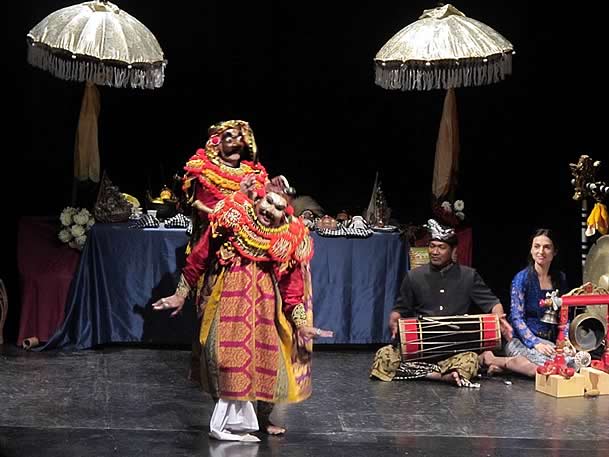|
|

The Exchanged Head |
 |
*
Veronica Piccoli
Rita Colani
Renato Carminati
Giuseppe Olivini
Saveria Savidya
Paolo Cucchi
Massimiliano Panza
Luciano Togni
Enrico Masseroli
|
Gangsa pemade
Gangsa pemade
Suling
Kajar/Ceng-ceng
Gong
Reyong
Reyong
Kendang
performer & direction
|
* |
PROGRAMM of the performance
Hujan Mas (Golden rain) famous music composition of the ’30, in Kebyar style
Baris literally means line (of soldiers). It 's an ancient warrior dance of ritual initiation, through which young boys show their physical maturity. In ceremonies it’s present in over 20 different styles, for groups ranging from 4 to 60 dancers. The solo form marks the transition from ritual participation to artistic virtuosity, a sequence of quick shots and short balances: surrounded by mysterious and hostile presences, the dancer is moved by creative energy with impeccable control. A tough challenge for the musicians to follow his darting!
Cewek Cantik (beautiful maiden) music composed by E. Masseroli
Topeng : The Exchanged Head
In the island of Bali theatre, music and dance are the very core of social and religious life, the expression of a culture where aesthetic and devotion are harmoniously linked. Topeng is one of the most old and popular style of the Balinese theatre. Its performance celebrates, between myth and history, the epos of old courts, providing as well an hilarious entertainment for everybody.
When only one performer plays all the masked characters, as by ceremonies, it is called Topeng padjegan (mixture). The actor changes in sight the amazing wooden masks giving (receiving, in Balinese eyes) life to ministers, kings and fools. The order of their entries show the feudal hierarchy and approaches the opposite aspect of life, from sacred to trivial, refined dances and sketches “Commedia dell’arte” alike.
Our performance tells the story of king Tapa Ulung, a rash ascetic who by accident got a pig’s head, thus becoming Bedahulu (the one with a changed head): i.e. the mythical explanation how Bali in the middle age became a province of the Javanese empire of Majapahit, precisely a very relevant historical matter.
The rich costumes, headdressesm and masks are strictly original, meanwhile the English translation of dialogs let European audience, included children and Bali’s ignorant people, understand and enjoy the amazing story. Beside it, the free jumps in actual reality made by the grotesque fools, mirrors the way how, still nowadays, Topeng is performed in Bali.
The masks and their characters The Noble court, fools, the protagonists of the story
Topeng Keras Minister. He who puts into practice the provisions of the king. Strong and resolute
Topeng Keras Lucu funny (lucu) Minister. Bully and prankster
Topeng Tua Old and wise counselor, can not conceal the infirmities of age.
Penasar Chamberlain. Servant witty and jovial. He’s the key character of Topeng, the "story teller". He translates from Kawi, the ancient literary language, into the three Balinese languages. The bridge between Indo-Javanese and Indo-Balinese cultures, linking the ancient feudal court and the common people
Topeng Dalem The King. A living archetype, androgynous symbol of perfection, combines in his dance male vigorous poses to female sinuous and elegant movements.
Wijil Younger brother of Penasar, joker, pedantic and slackers
Bonderes (fools) Grotesque commoners who enjoy complete freedom of expression. They can interact with the episode, as well as launching into impromptu raids in actuality. 5 in this show: Keto tour guide, jovial but stuttering
Pak Es ice cream seller, very excited as deaf.
Orang Toris tourist "by chance", his linguistic connotation may change according to location
Bondesa Tua old village chief, nostalgic and desperate
Nyoman Semariani dancer girl with apish face, flirting and claiming her irresistible charm
Patih Gadja Mada The famous and cunning minister sent from Java to Bali to restore order. The hero who sealed the annexation of Bali to the great Majapahit Empire in the fourteenth century
Dalem Bedahulu The pious king, who out of pride and/or fatality found himself with a pig's head. According to historical sources, put up a strong defense against the invading Javanese.
Sidha Karya literally "who has the power to complete the work (the rite)". His presence is necessary for the proper achievement of each ceremony of Topeng. His mask, with big bulging eyes and long fingernails, appears frightening and terrifying, at the same time feared and waited by children (sometimes he grabs one, pretending to kidnap him, and then offers him candy and coins). His vigorous and wild dance raises the hilarious amazement of onlookers and the attention of the demons, thus allowing the high priest (who in Balinese temple is working very closed) to carry out undisturbed his ritual prayer for the sanctification of the water.
Tabuh Penutup (traditional final music cue)

|
 |
|
Technical requirements:
The show can be presented in any space both indoors and outdoors.
Stage area minimum. 6 x 6 meters. Available at least 3 hours prior, to setting up.
Green room for 8 persons
Lighting: a fixed set without beamer, possibly coming from sides, with warm colors (amber / orange / pink / yellow jellies).
Duration: 85' ca.
|
| |